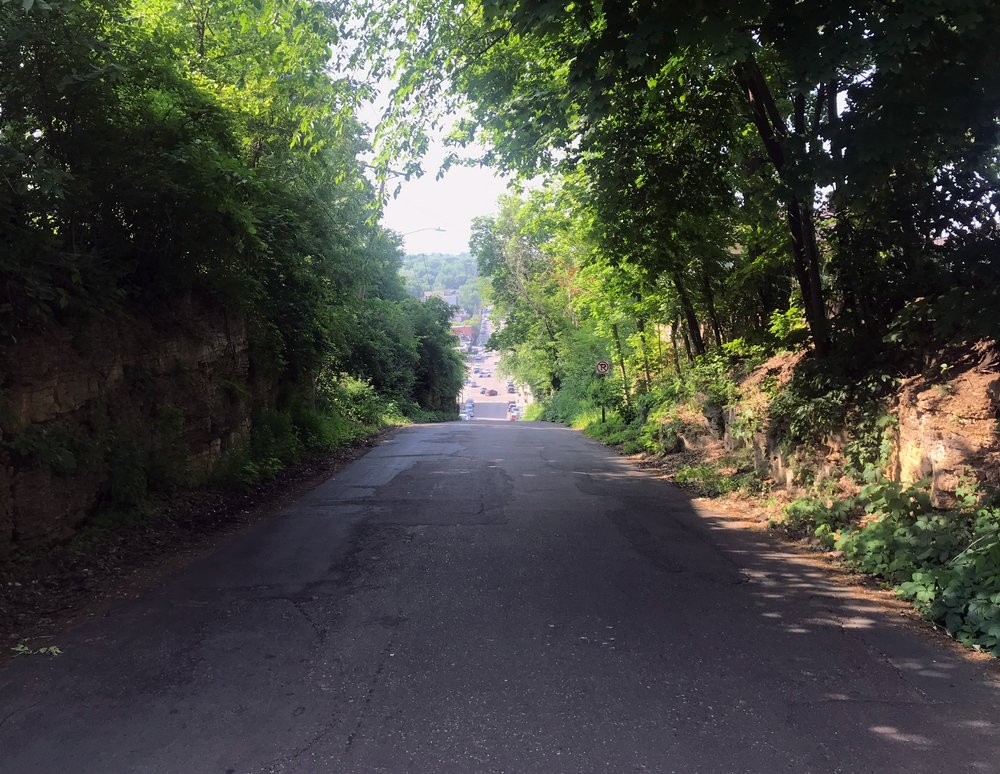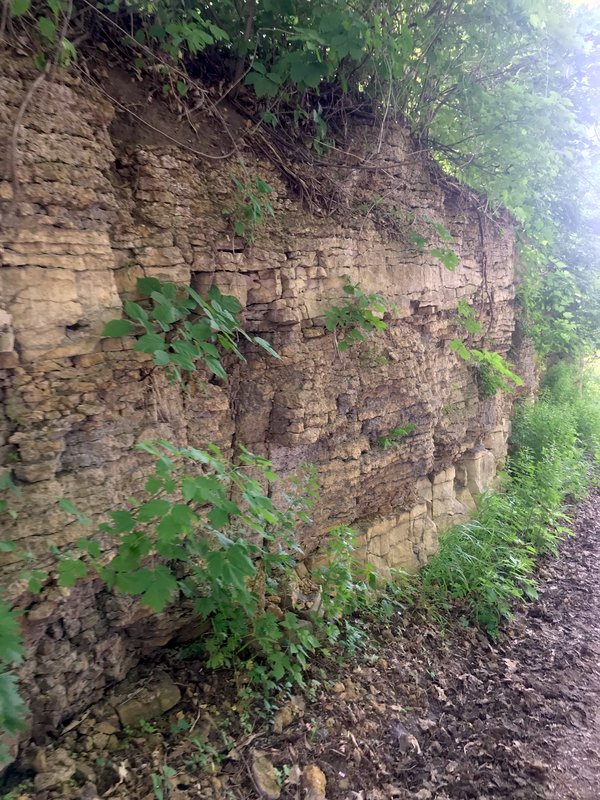Chilkoot Hill
One of Stillwater's best-known hill routes was built to keep horses away from streetcars.
Though South Second Street between Olive and Pine was a part of the original 1848 Stillwater town plat, its right of way traveled over steep bluff. Probably for that reason, the street was not constructed for decades. In those earlier days, the base of the hill was the start of another route called "Nelson's Grade", which continued west from today's Nelson Street, up the side of the ravine and ending on Third Street.
Construction
By early 1900, proposals to cut into the hill and build South Second Street began to appear in local newspapers. They were apparently the source of considerable controversy. After Stillwater's second streetcar system was constructed the previous year, farmers complained that the streetcars had made all routes into Stillwater too hazardous to haul full loads. South Main Street ran in close proximity to the railroad, and South Third Street was shared with the streetcars. Both routes raised the fear of accidents caused by spooked horses. At the same time, the muddy northern entrance from Dutchtown was deemed impassable, and the western hills too steep. The solution, according to its proponents, was to construct a road along South Second Street which would not be shared with streetcars or trains. Opponents believed that the existing routes were adequate, and better alternatives for a new route if one was necessary. ("I hope the people will drop it for a century," one wrote.) All parties agreed that constructing a road here would be a massive and expensive undertaking.[1]
The City Council was apparently convinced, and by March 1901 blasting had begun to create a narrow 30 foot wide road road. It was a long project and not completed until early 1902. Original plans called for a bridge in the ravine area at the intersection of Second and Nelson, but the street commissioner saved $5,000 by building up the hill with fill.[2]
Despite the cost and length of the project, residents were optimistic about the ultimate outcome. By June 1901, the previously-skeptical Stillwater Messenger predicted that South Second Street would be the most popular route to downtown once it was completed. A few months later, the committee in charge of the new Stillwater Carnegie Library project was struggling to find a building site that was central yet affordable. Two articles in the Messenger proposed that the library be located on the improved South Second Street.
A Now-Familiar Nickname
Soon after the street's construction, it acquired the name by which it is best known today. Edward Durant, a state senator and former mayor who lived at the top of the hill, began referring to it as "Chilkoot Pass" in reference to a famously challenging trail followed in the Klondike gold rush of a few years earlier. "Chilkoot Hill" is widely known among Stillwater residents today, though the Messenger's predictions for the street's future traffic levels are far from the quiet modern reality.[3]
Sledding
It didn't take the young people of Stillwater long to decide the hill had potential for winter sledding. A newspaper editor described the scene in January 1905:
As a popular resort, during these charming winter days and moonlit nights, “Chilcoot Pass” is among the chiefest—that is, among the juvenile portion of the community. There seems to be implanted in the breast of man—speaking in a general sense and including old and young—a wish, a desire for rapidity of motion, for being propelled from one place to another with something akin to the hurricane’s rush, and on Chilcoot Pass this desire finds its full fruition. But even in this enjoyment there comes an occasional drawback—they have to draw back the sled for one thing, but that is trivial compared to the danger of life and limb, ever present where a hundred, more or less, of thoughtless boys and girls are descending that steep incline with the speed of the wind, while others, equally as thoughtless, are toiling up the hill with their vehicles. A day or two ago, as we wended our way decorously—not to say laboriously—up that famous pass, we saw a boy coming down, rapidly of course, who seemed to have no control of his fast-flying sled. We watched him with natural solicitude, and sure enough there was a boulder over there on the off side of the track—one of these heavy boulders that lay snug to the ground and are not easily moved. And the way the youngster was steering—or was not steering—brought his sled in line with the boulder, and the result may be guessed. The vehicle suddenly stopped; so did not the boy; that is, he didn’t stop right there. He was shot straight ahead, catapult fashion, landing twelve or fifteen feet further down the incline. He stated some remark about the time he handed, the exact import of which we were unable to catch.[4]
“The Wicked Witch of All Hills": Bike Racing Up Chilkoot
The hill grew to have some recognition beyond Stillwater residents starting in 2004, when it was the centerpiece of a bicycle race originally known as the Great River Energy Bicycle Festival. The competition's final day featured repeated laps around a Stillwater course, with some cyclists climbing Chilkoot's 24 percent grade up to 20 times in 70 minutes. A St. Paul Pioneer Press writer observed: "Stillwater's Chilkoot Hill is not the granddaddy of all hills. With greenery forming a dark hat and warty outcroppings of rock lining her steep face, Chilkoot is more like the wicked witch of all hills." The annual race continued under various names through 2015.[5]
Chilkoot Hill also lends itself to a bicycle shop on the South Hill, as well as a Stillwater-based cycling club.
More Reading
"Chilkoot Hill" by Brent Peterson in Stillwater Gazette
References
-
Stillwater Messenger, 24 February 1900, p. 5. Stillwater Messenger, 3 March 1900, p. 7. Stillwater Messenger, 10 March 1900, p. 8.
↩ -
"Council Meeting", Stillwater Messenger, 23 March 1901, p. 4. "The work on the grade of the South Second street hill has been discontinued...", Stillwater Messenger, 16 November 1901, p. 4. Peterson, Brent T. "Chilkoot Hill", Stillwater Gazette, 17 October 2018, online edition.
↩ -
Peterson 2018.
↩ -
"City and Surroundings", Stillwater Daily Gazette, 20 January 1905, p. 3.
↩ -
Amy Becker, "Stillwater Hill Will Test Bikers", St. Paul Pioneer Press, 12 June 2004, p. B1. Kathy Berdan, "Twin Cities bike race will have to hit the brakes without funding", St. Paul Pioneer Press, 23 April 2019, online edition.
↩


